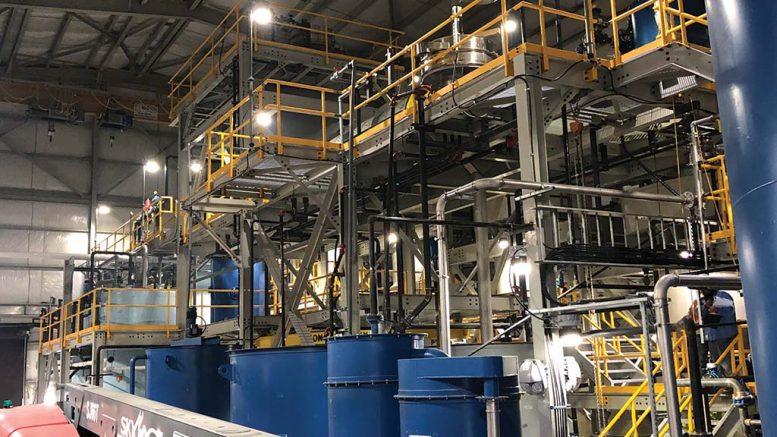McEwen Mining (TSX: MUX; NYSE: MUX) will soon be pouring first gold at its new Gold Bar mine in central Nevada, just 14 months after breaking ground in November 2017.
Commercial production is forecast to follow before the end of the first quarter, which is a dramatic schedule, says Chris Stewart, the company’s president.
“I’d say that’s pretty darned good,” he says. “Typically, you’re into quite a longer time frame than that, especially when you’re looking at underground mines. Gold Bar is an open-pit mine, but the timeline we’ve put together is pretty impressive, and we’re looking at bringing it in on budget — at around US$81 million. We’re tracking at US$81.4 million right now.”
A lot of the preparation work, including engineering, was done early as the company awaited permitting, which enabled it to “hit the ground running” when the permits arrived in November 2017, Stewart explains.
“There weren’t any concerns about getting the permit, just the timing around it,” he says. “It was a fairly quick turnaround because it’s in a known mining area. It’s not like it’s a new concept for the people there, or the regulators.”
Exploration last year also extended Gold Bar’s estimated mine life to 7.4 years. This year the company plans to spend US$5.05 million on exploration drill targeting near surface and deep Carlin-type mineralization on the property this year.
McEwen Mining says the addition to the mine plan of the Gold Bar South resource should extend the mine life by one year.

Gold ore under the leach pad at Gold Bar. Credit: McEwen Mining.
“The 7.4 years don’t include Gold Bar South, which we’re actively working on right now, with some more drilling,” Stewart says. “We will most likely have our existing resource upgraded for Gold Bar South by the end of this year.”
McEwen Mining acquired Gold Bar South, 5 km from the Gold Bar project, in January 2016.
This year exploration will target near-surface extensions, including Gold Bar South, as well as looking at depth to see what can be found there, Stewart says.
“There’s significant potential to find more gold at depth,” he says. “We’re on the Battle Mountain Cortez trend — company-makers, as far as gold mines go.”
Gold Bar is 40 km south of Barrick Gold’s (TSX: ABX; NYSE: GOLD) Nevada operations and 40 km north of Waterton Global’s Ruby Hill mine.
“We’re on the same structure as Barrick’s Goldstrike and Cortez mines,” he says. “Goldstrike has 50 million oz. just to the north of us, on the same trend we’re on … and Cortez has 10 million oz., and we really haven’t done a lot of work looking at depth yet, so that’s something we’ll be doing this year.”
Stewart estimates Gold Bar will produce 55,000 oz. gold this year at an all-in sustaining cost of US$975 per oz. gold.
The mine is expected to produce an average of 62,000 oz. gold a year over its mine life at cash costs of US$770 per oz., and all-in sustaining costs of US$843 per oz. gold.
A feasibility study in February 2018 estimated capex of US$81 million, and a three-year payback based on US$1,250 per oz. gold. The study forecast a 23% post-tax internal rate of return and US$54-million after-tax net present value at a 5% discount rate.
McEwen Mining already has three operating mines: Black Fox in Ontario’s Timmins district, the El Gallo gold-silver mine in Mexico, and its 49%-owned San Jose gold-copper mine in southern Argentina.
Development projects include the Gallo Silver project near the El Gallo mine, and the large, low-grade Los Azules copper asset in Argentina’s San Juan province.
McEwen Mining’s shares have traded within a 52-week range of $2.16 to $3.28 per share. At press time, shares were trading at $2.39.
The company has 345 million common shares outstanding for an $825-million market capitalization.


Be the first to comment on "McEwen closes in on production at Gold Bar"